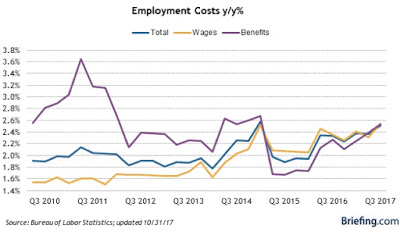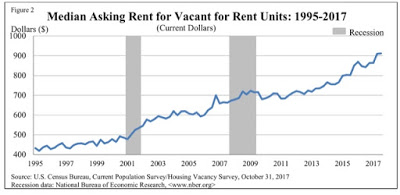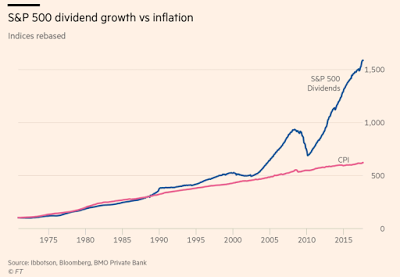Summary:
Some comments on the economic data from yesterday and this morning… 1. Personal income and spending. Real, inflation adjusted income was flat, while real spending was up +0.6%. Which means the personal saving rate declined to a new expansion low: We’ve had a steep decline in the savings rate in the past year. That is something that, as the above graph shows, tends to happen in mid- to late expansion. The upshot is that consumers have less room in their budgets to absorb a future negative shock. 2. The employment cost index. This is some good news. The employment cost index is a median measure, and it tracks payment for the same job over time, and it improved 0.7% q/q, and the longer term trend is positive: YoY growth of wages, at 2.5%,
Topics:
NewDealdemocrat considers the following as important: US/Global Economics
This could be interesting, too:
Some comments on the economic data from yesterday and this morning… 1. Personal income and spending. Real, inflation adjusted income was flat, while real spending was up +0.6%. Which means the personal saving rate declined to a new expansion low: We’ve had a steep decline in the savings rate in the past year. That is something that, as the above graph shows, tends to happen in mid- to late expansion. The upshot is that consumers have less room in their budgets to absorb a future negative shock. 2. The employment cost index. This is some good news. The employment cost index is a median measure, and it tracks payment for the same job over time, and it improved 0.7% q/q, and the longer term trend is positive: YoY growth of wages, at 2.5%,
Topics:
NewDealdemocrat considers the following as important: US/Global Economics
This could be interesting, too:
Joel Eissenberg writes How Tesla makes money
Angry Bear writes True pricing: effects on competition
Angry Bear writes The paradox of economic competition
Angry Bear writes USMAC Exempts Certain Items Coming out of Mexico and Canada
Some comments on the economic data from yesterday and this morning…
1. Personal income and spending.
Real, inflation adjusted income was flat, while real spending was up +0.6%. Which means the personal saving rate declined to a new expansion low:
We’ve had a steep decline in the savings rate in the past year. That is something that, as the above graph shows, tends to happen in mid- to late expansion. The upshot is that consumers have less room in their budgets to absorb a future negative shock.
2. The employment cost index.
This is some good news. The employment cost index is a median measure, and it tracks payment for the same job over time, and it improved 0.7% q/q, and the longer term trend is positive:
YoY growth of wages, at 2.5%, is just below the expansion peak of 2.6%. At least in terms of measuring payment for the same job, there actually is some improving wage growth.
3. Apartment rents.
The median asking rent for apartments rose by $2 to $912 in the third quarter
Rental price pressures are accelerating!
4. Regional manufacturing.
The Dallas Fed and the Chicago PMI both improved even more from September to October:
As a result, even taking into account that these have been outperforming industrial production this year, it is likely that manufacturing production when it is reported for October several weeks from now will be a positive, and most likely slightly better than last month’s.
These releases are all consistent with an economy that is doing extremely well right now, while laying the groundwork for the ultimate downturn in the form of additional pressures on the consumer.
Dividend Yields Are Outperforming Inflation
This chart is from the Financial Times:
As I point out in my book The Lifetime Income Security Solution, dividends are a key component to investing. They lower overall volatility, steady performance and provide a constant stream of reinvestment income . The above chart partially explains why. Treasury yields started to drop in the early 1980s and have continued to plumb new lows since. While many people have correctly noted that yields have nowhere to go but up from their current position, it’s doubtful we’ll see a major advance with inflation so low. Add all this information together and you have a powerful argument for focusing on dividends.
You can read all about it in my book (shameless plug):







